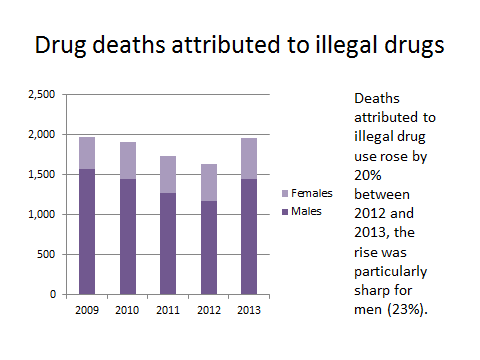Deaths that were attributed to illegal drug use rose by 20% in 2013 to 1,957 contributing to the overall number of drug deaths (both legal and illegal) which at 2,995 are the highest levels since 2001.
Over half of all drug related deaths involved an opiate, and for men in their 30s this rose to two in three (68%). The most commonly recorded opiates were heroin and/or morphine which were seen in 765 deaths a 32% increase from 2012. They also record 429 deaths where methadone was detected.
The ONS suggest that the end of the ‘heroin drought’ which has seen rising purity of street heroin may explain the increase in the number of deaths associated with the drug.
But there are a number of other drugs where 2013 is the year with the highest number of deaths since records were started. These include:
- Amphetamines including ecstasy (120),
- New Psychoactive Substances (60),
- benzodiazepines (342), and
- tramadol (220)
Also worth noting is that while alcohol deaths are recorded separately, in 30% of the cases in this report there was a mention of alcohol or long term conditions associated with alcohol abuse, in addition to drugs, in the coroners’ reports.
Men in their 30s, followed by those in their 40s, had the highest mortality rates as a result of drug use. And the ONS point out that:
The male mortality rates in these two age groups were significantly higher than the rates in all other age groups, and much higher than females of any age.However, in a background note, they do point out that nearly 1 in 7 deaths among people in their 20s and 30s were drug related.
Marcus Roberts, DrugScope’s Chief Executive, in our response to these figures says:
DrugScope has grave concerns over the significant increase in the number of drug-related deaths registered in England and Wales last year. The figures mark a reversal of the recent downward trend and appear to show the sharpest increase since the early 1990s. Of course, this is about more than just numbers; each death represents a tragedy for the individual concerned, their family and friends.In 2012, the Advisory Council on the Misuse of Drugs (ACMD) reported to the Home Secretary that naloxone saves lives and ‘fits with other measures to promote recovery’, concluding that the drug should be made more widely available. While the government (in 2014) accepted this recommendation, the current date for implementation is still a year away, in October 2015.
In our media release, we call on the Home Office and Department of Health to reconsider that timetable, “so that this life-saving medication can be used sooner, to prevent more people from dying.”


No comments:
Post a Comment